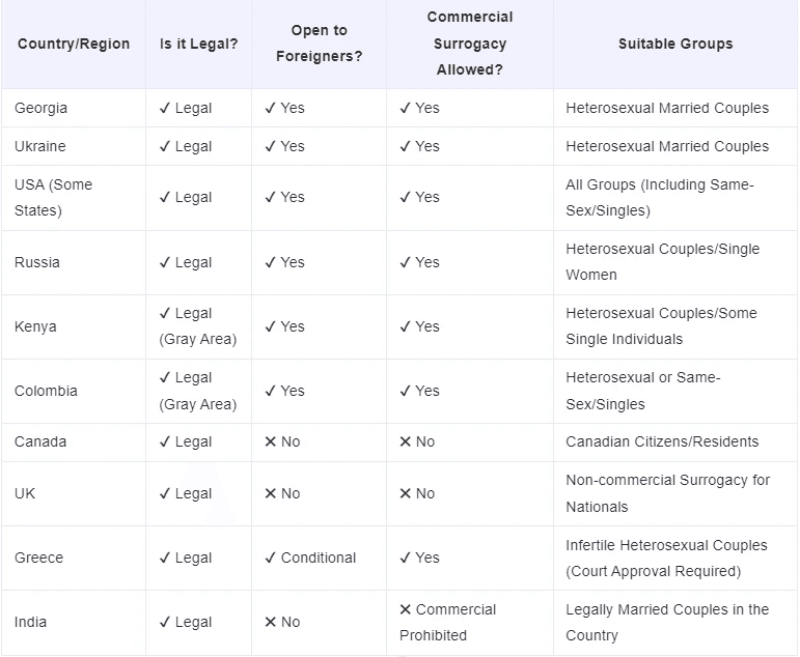Introduction: Surrogacy in the Modern Era
In recent years, surrogacy has become an increasingly popular and widely discussed option for individuals and couples seeking to build a family. Whether due to infertility, medical conditions, or same-sex relationships, many people are turning to surrogacy as a viable path to parenthood.
As societal norms evolve and reproductive technologies advance, the global surrogacy industry is experiencing both growth and transformation. However, this complex field remains influenced by legal restrictions, ethical debates, cultural differences, and economic considerations.
This article provides a comprehensive overview of surrogacy—its types, current global status, medical processes, legal frameworks, and emerging trends. By understanding these aspects, readers can gain valuable insights into how surrogacy works today and where it might be headed tomorrow.

Understanding Surrogacy: Types and Medical Procedures
What Is Surrogacy?
Surrogacy is a reproductive arrangement in which a woman (the surrogate) agrees to carry and give birth to a child on behalf of another individual or couple (the intended parents). The process typically involves assisted reproductive technology (ART), especially in vitro fertilization (IVF).
Types of Surrogacy
There are two main types of surrogacy:
- Traditional Surrogacy
In traditional surrogacy, the surrogate uses her own egg and is artificially inseminated with the intended father’s sperm. This makes her the biological mother of the child. While simpler and less expensive than gestational surrogacy, it poses more legal and emotional complexities due to the genetic link between the surrogate and the child.
- Gestational Surrogacy
More commonly practiced today, gestational surrogacy involves transferring an embryo created through IVF into the surrogate’s uterus. The embryo may come from the intended parents’ gametes, donor eggs or sperm, or a combination of both. Since the surrogate has no genetic connection to the child, establishing legal parentage is generally easier.

The Global Landscape of Surrogacy
Surrogacy practices vary significantly across the globe, shaped by legal policies, cultural attitudes, and economic factors.
United States: A Leading Surrogacy Destination
The United States is one of the most popular countries for international intended parents due to its advanced fertility clinics, relatively favorable legal environment, and availability of willing surrogates.
However, surrogacy laws in the U.S. are not uniform. Some states, like California and Nevada, have clear legal frameworks that allow commercial surrogacy and establish parental rights before birth. Others either restrict or ban surrogacy entirely, creating logistical challenges for cross-state or international clients.
India: From Surrogacy Hub to Regulatory Restriction
India was once a major global hub for surrogacy due to its low costs and high-quality medical care. However, the Indian government passed the Surrogacy (Regulation) Act, 2021, which now limits surrogacy to Indian married couples and only allows altruistic arrangements among close relatives.
This policy shift was driven by concerns over exploitation, lack of legal protections for surrogates, and cases of children being left stateless due to unclear parentage laws.
Thailand and Nepal: Controversies and Legal Changes
Thailand became a popular destination for international surrogacy until several high-profile legal disputes involving parentage and citizenship arose. As a result, the country implemented strict regulations banning commercial surrogacy for foreigners.
Similarly, Nepal briefly entered the surrogacy market but shut down operations after facing similar issues.
Europe: Diverse Legal Frameworks
European countries exhibit a wide range of surrogacy laws. The United Kingdom permits altruistic surrogacy but prohibits commercial compensation. France, Germany, and Italy ban surrogacy altogether. Meanwhile, Greece and Ukraine have emerged as attractive alternatives due to their relatively liberal laws and lower costs compared to Western Europe.
Canada: Altruistic Model with Strong Legal Protections
Canada allows surrogacy but does not permit commercial payment beyond reasonable expense reimbursement. The country emphasizes the rights of all parties involved and offers a well-structured legal system for establishing parental rights.

Medical Advancements Driving the Surrogacy Industry
Technological progress in reproductive medicine continues to enhance the success and safety of surrogacy.
In Vitro Fertilization (IVF)
IVF is the foundation of gestational surrogacy. It enables embryos to be created outside the body and transferred to the surrogate’s uterus, ensuring a genetic link between the child and the intended parents when using their own gametes.
Preimplantation Genetic Testing (PGT)
PGT allows for screening embryos for chromosomal abnormalities before implantation. This increases pregnancy success rates and reduces the risk of certain genetic disorders.
Egg and Sperm Freezing
Improved cryopreservation techniques have expanded options for single individuals and same-sex couples, allowing them to preserve genetic material for future use in surrogacy.
Uterine Transplants and Artificial Wombs (Future Possibilities)
While still experimental, uterine transplants and artificial wombs could one day offer alternatives to surrogacy, particularly for individuals with uterine factor infertility.

Legal and Ethical Considerations in Surrogacy
Despite its growing popularity, surrogacy remains a topic of intense debate due to its legal and ethical implications.
Parental Rights and Cross-Border Complications
One of the most pressing legal issues in surrogacy is the establishment of parental rights, especially in international cases. Discrepancies between the laws of the surrogate’s country and those of the intended parents’ home country can lead to situations where children are born stateless or face difficulties obtaining citizenship.
For example, children born via surrogacy in Thailand or India previously faced legal limbo when host nations refused to recognize foreign parentage orders.
Surrogate Welfare and Fair Compensation
Ethical concerns center around the treatment and compensation of surrogates. Critics argue that surrogacy can exploit economically disadvantaged women, particularly in developing countries where financial incentives may outweigh informed consent.
Proponents emphasize that surrogacy can be mutually beneficial when conducted ethically, with fair compensation, proper medical care, and psychological support for surrogates.
Commercial vs. Altruistic Surrogacy Debate
The debate over whether surrogacy should be commercialized or limited to altruistic models continues globally. Commercial surrogacy allows surrogates to receive payment beyond expenses, which supporters argue recognizes the physical and emotional labor involved. Opponents fear it commodifies reproduction and creates potential for coercion.
Altruistic surrogacy, while seen as more ethically acceptable, can limit the number of available surrogates and make the process more emotionally complex, especially when family members are involved.

Cultural Attitudes Toward Surrogacy
Cultural perceptions of surrogacy vary widely and often influence national policies.
In many Western societies, surrogacy is increasingly accepted as part of broader discussions about family-building and LGBTQ+ rights. It is often viewed as a compassionate act that helps people fulfill their desire to become parents.
Conversely, in some conservative or religious communities, surrogacy is met with skepticism or outright rejection due to concerns about disrupting traditional notions of parenthood and reproduction.
Social media and advocacy groups have played a crucial role in normalizing surrogacy and sharing personal stories, contributing to greater public awareness and acceptance.
The Role of Surrogacy Agencies and Intermediaries
Surrogacy agencies play a vital role in facilitating matches between intended parents and surrogates, coordinating medical appointments, managing legal paperwork, and providing psychological support.
Reputable agencies ensure transparency, ethical standards, and compliance with legal requirements. However, the industry has also seen cases of fraud, unregulated brokers, and poor oversight, particularly in countries with weak regulatory frameworks.
As demand grows, there is a need for greater standardization and oversight within the agency sector to protect all parties involved.
Future Trends and Predictions in Surrogacy
Looking ahead, several trends are likely to shape the future of surrogacy:
Increased Regulation and International Cooperation
As surrogacy becomes more globalized, governments and international organizations will likely push for greater harmonization of laws and agreements to address cross-border complications. We may see the development of international treaties or guidelines governing surrogacy arrangements, akin to the Hague Convention on Intercountry Adoption.
Rise of Ethical and Transparent Practices
Consumers are becoming more conscious of ethical sourcing and human rights issues. As a result, surrogacy programs that prioritize surrogate welfare, informed consent, and fair compensation are likely to gain prominence. Certification programs and accreditation standards for clinics and agencies may emerge to meet this demand.
Technological Innovations
Continued advances in reproductive technology will enhance the efficiency and success rates of surrogacy. Artificial intelligence may assist in matching intended parents with suitable surrogates, while blockchain technology could provide secure, transparent records of surrogacy contracts and medical histories.
Broader Social Acceptance and Legal Recognition
With increasing visibility and advocacy, surrogacy is expected to gain wider social acceptance. Legal systems may adapt to better accommodate non-traditional families, ensuring smoother processes for establishing parental rights and protecting the interests of all stakeholders.
Emergence of New Markets
While traditional surrogacy hubs have seen regulatory tightening, new markets may emerge in regions with stable legal environments and growing fertility industries. Countries in Eastern Europe, Latin America, and Southeast Asia could position themselves as attractive alternatives, provided they implement responsible regulatory frameworks.

Conclusion: Building a Responsible and Sustainable Surrogacy Future
Surrogacy represents a powerful convergence of science, compassion, and human aspiration. For many individuals and couples, it offers the opportunity to build a family when other paths are closed. Yet, it also presents significant ethical, legal, and emotional challenges that must be navigated with care.
As the industry matures, the focus must shift from merely enabling surrogacy to ensuring that it is practiced ethically, transparently, and sustainably. This requires collaboration among lawmakers, medical professionals, advocacy groups, and the global community.
Ultimately, the future of surrogacy lies in balancing innovation with humanity—creating systems that protect the dignity and rights of surrogates, intended parents, and the children at the heart of every journey.
Whether you're considering surrogacy as a path to parenthood, a potential surrogate, or simply someone interested in understanding this evolving field, staying informed and engaged is essential. The story of surrogacy is still being written—and its next chapter holds great promise for building families across borders, cultures, and circumstances.
